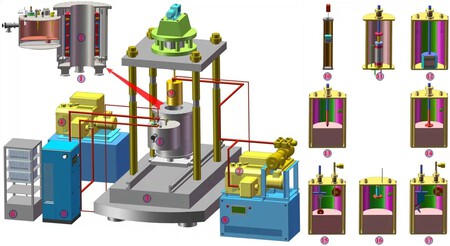China builds “artificial moon” that simulates low-gravity conditions

What do you do if you are a country that is preparing for its first manned missions to the Moon and you want everything to go well? Simple: you build yourself an “artificial moon” to practice. At least that’s what China has done.
A group of scientists from the China University of Mining and Technology, inspired by the experiments that they made a frog levitate with magnets, It has built a research facility capable of simulating lunar low gravity.
A small artificial moon for conducting experiments
The simulator, located in the city-prefecture of Xuzhou, has a vacuum chamber that houses a “mini moon” measuring 60 cm in diameter. The surface of it is set with dust and rocks that help to simulate the lunar landscape.
Li Ruilin, the lead researcher on the project, assures that it is “the first simulator of its kind in the world.” It also indicates that its effectiveness is so good that it can make gravity “disappear” without time limit.

The scientist recalls that to simulate low gravity on Earth, it is currently required to fly in a plane that enters free fall and then rises again or from a falling tower. Nevertheless, those experiences usually last about two minutes.
To overcome the hurdle of time, the researchers used a magnetic field to simulate “levitation effects.” “Some experiments, like a bump test, only take a few seconds. But others, like stress tests, can take several days,” explains Ruilin.

Researchers They were inspired by magnetic levitation work by Andre Geim to build the simulatedr. The Russian physicist won an Ig Nobel Prize in 2000, whose slogan is “First they make people laugh, then they make them think”, for making a frog “float”.
Andre Geim told South China Morning Post that he was pleased to see that his experiments were helping space exploration applications, although warned that “magnetic levitation is not the same as antigravity”.
At the moment the simulator is preparing for its official presentation “in the coming months”. However, the researchers They are confident that it will play a key role in future Chinese missions to the Moon., by allowing testing of equipment and thus “avoiding costly miscalculations.”
In recent years, China has bet heavily on exploring the Moon. To mention a few examples, the Chang’e 4 mission sent, among other things, curious images of the lunar hidden face, including the mysterious cube that was later found to be simply a rock.
Chang’e 5, meanwhile, returned in December 2020 with rock samples from the satellite. Now, in addition to the Chang’e-6 and Chang’e-7 missions planned in the future, the Asian giant is expected to build with Russia a permanent base on the south pole of the Moon.
Via | South China Morning Post
Images | v2osk | China University of Mining and Technology
Reference-www.xataka.com